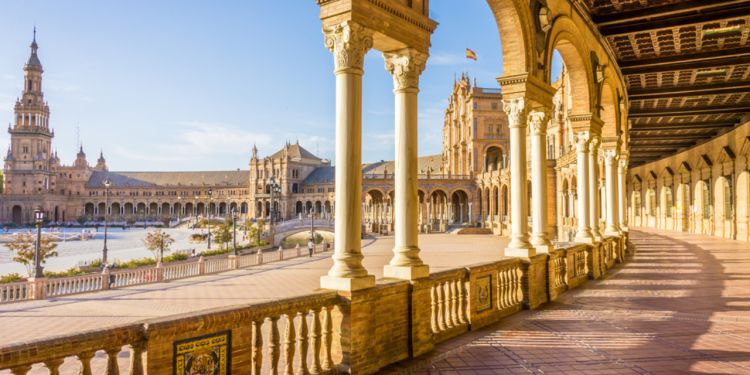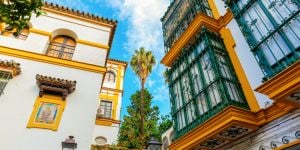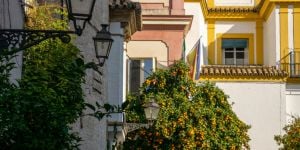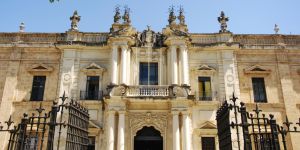
Seville is a southern Andalusian city that's easy to fall in love with. The Moorish architecture, works of art, ancient buildings, good schools, welcoming neighborhoods, and well-connected transport infrastructure make it a great place to live and work.
Each neighborhood in Seville has its own distinct look and feel, and whether you're looking to rent or buy a home, there's a variety of options.
Where to begin your housing search in Seville
It is always a good idea to start your search before you come to Seville. You can begin by browsing real estate websites such as idealista.com and thinkspain.com and online classified ads on milanuncios. Also check out expat and neighbourhood forums on social media. Another option is simply to type in "Seville rental property" or "Seville homes for sale" into a search engine.
Note that with an online search, some of the advertised properties might not be available when you contact the agent. They often 'forget' to remove unavailable properties because they want a lot of potential customers to contact them.
Once you are in Seville, drive or take public transport to the different neighborhoods. Walk the streets to get a feel for each area. Look for homes with se vende (for sale) or se alquila (for rent) boards.
You could even call local estate and rental agents. Tell them what you're looking for and when you're moving to the city, and ask them to email lists of suitable properties.
Rental prices in Seville
Like any city, Seville has a variety of accommodation types, including villas, apartments, off-plan properties and cortijos (traditional rural homes). To rent a one-bedroom property near the city center, expect to pay between 700 euros and 1,100 euros per month. For a one-bedroom property outside of the center, you will probably pay between 500 euros and 900 euros per month.
If you're looking for something bigger, a three-bedroom apartment can cost between 1,110 and 1,600 euros per month in the center and between 750 and 1,300 euros outside of the central area.
Other Seville rental options include flat sharing, renting a room in a home and staying with a Spanish family. This latter option is also a great way to improve your level of Spanish.
How to find cheap rentals in Seville
Finding affordable housing in Seville can be challenging, especially if you are on a tight budget. So here are a few tips to get you started.
- Set a budget: Determine how much you can afford to spend on rent each month;
- Research different neighborhoods: Look for areas that are known to be more affordable. These include Alameda and Triana;
- Consider sharing with roommates: Sharing a flat with others can help split the cost of rent and other expenses;
- Check for available student housing: If you are a student in Seville, there may be affordable housing options available through your university/college;
- Contact local real estate agencies: Contacting local real estate agents can give you access to rentals not advertised online;
- Negotiate with the landlord: Try to negotiate a lower rent or ask if they'd be willing to include some utilities for free;
- Be flexible with move-in dates: If you can move in at a less desirable time, landlords may be more willing to lower rental prices.
Good to know:
You will have to give one month or two months' rent as a deposit plus the rent for the first month in advance. Your deposit will be paid back to you at the end of the rental term, less any money that needs to be paid for damage or repairs.
Tips for renters in Seville
- You will need to budget for more than the monthly rent. Additional expenses can include water, gas, electricity, and internet/telephone costs.
- When you're viewing properties, note any imperfections that you may be able to use to negotiate the price.
- Make sure you've fully understood the rental contract and your obligations as a tenant. It will most likely be in Spanish, so if you don't speak the language, hire a translator to help you. However, if you use an English rental agency, they might provide you with a copy in English as well.
- You don't need to stay with the landlord's utility companies. So, it may pay you to shop around to find cheaper options.
- When viewing properties in Seville, check that there is good mobile phone coverage in each of the rooms. You probably don't want to be in a home where connectivity is patchy at best. Ask if fiber optic has been installed.
- Your rental property should come with an inventory detailing all the items included in the home, such as a washing machine, cutlery and television. Draw up your own checklist if one is not provided, and get the landlord to sign it.
- Classified ads in Seville may not detail whether a property is furnished or unfurnished. Therefore, it is always worth checking with the landlord or rental agent to be sure about what you're getting for your money and whether you will have to buy a sofa, television, and other items.
- If you're paying your rent or deposit in cash, make sure you get a receipt.
Neighborhoods in Seville
The city of Seville comprises 11 districts and more than 100 neighborhoods, from medieval quarters and modern areas to bohemian enclaves and upscale environs. The most popular neighborhoods for expats to live in Seville are Santa Cruz, Triana, and El Arenal.
Santa Cruz
The former Jewish Quarter is an attractive old town of cobbled streets, hidden squares and some of the city's best tapas bars. This is one of the oldest neighborhoods in Seville. Like the city center, it is a lively hub and always filled with tourists. If you relish your peace and quiet, this may not be the place for you to rest your head at night. Many of the city's oldest churches are located here among the labyrinth of streets.
The average price per month for rented accommodation in Santa Cruz is around 18 euros per square meter.
Triana
This is probably Seville's most famous neighborhood, a former gypsy quarter that has produced some of Spain's most influential flamenco artists and bullfighters. The area is also celebrated for workshops that make azulejos (ceramic tiles). Homes in Triana tend to be older than those in many other parts of Seville.
Like, the city center and Santa Cruz, this is another busy area popular with tourists. Places to visit include shops selling ceramics, the Church of Santa Ana and Triana Market, the daily fresh food market.
The average monthly rental accommodation price in Triana is around 13 euros per square meter.
El Arenal
This old neighborhood was once the home of the city's port, where trading ships departed on voyages to the New World. These days, it is a smart and well-heeled residential suburb with expensive homes. Famous sights include the bullring and the Torre del Oro. This 13th-century former military watchtower is now home to a naval museum.
The average price per month for rented accommodation in El Arenal is 15.76 euros per square meter.
Following are some of the Andalusian capital's other principal neighborhoods:
City Centre
The city's beating heart is a continual buzz of activity and is home to trendy bars, great nightlife, Seville's main attractions, and many places to shop. Because you're in the center, many of the sights you will want to visit are within easy walking distance. However, convenience comes at a cost. Property rental and purchase prices are more expensive here than anywhere else in the city.
Alameda
Seville's trendiest neighborhood surrounds the tree-lined Alameda de Hercules, just north of the city center. It is a colorful place of trendy bars and cafés, vegetarian restaurants, creative spaces and boutiques. The area is also the center of Seville's LGBT scene.
Los Remedios
One of the most modern parts of the city is home to large blocks of contemporary apartments and long, wide boulevards. This is Seville's only purpose-built residential district, and it's located south of Triana on the west bank of the Guadalquivir River.
Macarena
Once one of the poorest parts of the city is now a trendy and colorful enclave partially enclosed by a section of Sevilla's ancient city wall, it is home to numerous churches, palaces, plazas and the city's oldest market, the Mercado de la Feria.
Nervion
Seville's business district is an up-and-coming area with new apartment blocks, plenty of bars and restaurants and excellent transport links to the rest of the city. The Santa Justa station can be found here, which is Seville's main railway station.
Many students live in Nervion because of its proximity to Seville's university faculties.
Rental agreements in Seville
Renting a home in Seville typically involves signing a rental agreement, a legally binding contract between the landlord and the tenant. It typically includes the monthly rent amount, payment due date, how it should be paid, security deposit amount, the length of the rental term and any additional fees or charges that may apply. Generally, rental agreement terms in Seville are for 11-12 months and some will have a clause to renew if required.
Other common conditions and formalities when renting a home in Seville include providing proof of income and employment, a copy of a valid ID or passport, and references from previous landlords or rental agencies.
In addition, tenants are usually responsible for maintaining the property in good condition and adhering to any rules or regulations outlined by the landlord or property management company. This may include restrictions on pets, noise levels, and smoking, among other things.
The agreement helps to protect the interests of both parties and provides a framework for managing the relationship between them.
Deciding on where to live in Seville
Whether you are relocating to Seville temporarily for work or moving to the city on a permanent basis, there are some essential things to consider before making the transition. For example, the importance of location, location, location cannot be overstated.
Here are some of the most important considerations when deciding where to live in Seville.
- Do you want to live among people from your own country, the Spanish, or a mixture of the two?
- Do you need to be close to the city center or the countryside?
- Is the neighborhood quiet?
- If you have children, what are the local schools like? Are there parks and leisure areas close by?
- Does the neighborhood have good public transportation links?
- Is the home close to shops and other amenities?
- What is it about a location that makes you happy?
Property prices in Seville
Seville's housing market came through the COVID-19 pandemic in reasonably good shape. Although, in general, prices dropped, it was nowhere near the calamitous collapse that some forecasters had been predicting. During the last couple of years, property prices have been steadily increasing, and experts believe this trend will continue at least in the short term.
According to Numbeo, the world's largest cost of living database, the price per square meter for an apartment in the city center ranges from 3,100 euros to 3,800 euros. Outside the center, the price per square meter to buy an apartment ranges from 1,800 euros to 2,500 euros.
Buying a home in Seville
In your native country, buying the right home can take time. So too, in Spain. It is unlikely you'll fall in love with the first property you set eyes on or visit. Be prepared to check out a few homes before you settle on the property of your dreams.
If you don't speak the language, the buying process in Seville may take a little longer. There will be forms and contracts to translate so you can fully understand what is going on.
To help your home purchase go smoothly, you will need to assemble a top team of specialists. They include:
Gestor
The gestor/asesoria will advise you on every stage of the home-buying process in Seville. Among the jobs they will perform are:
- Help you obtain your NIE
- Verify the purchase contract is correct
- Conduct necessary searches
- Pay deposits
- Arrange for utilities to be transferred to your name
- Accompany you to the notary for signing the title deed
- Register the new title deed
- Translate all the documents you need to read
- Lawyer
Your lawyer will check that the property you're buying is legal. They will also do the following:
- Check the property registry
- Check local records for debts on the property and plans
- Check the size of the house and look for any extensions that haven't been declared
- Check the person selling the home is the owner and has the right to sell it
- Check to see if anyone is contesting the right to sell the property
Notary
Notaries are public officials who play a neutral role in a range of legal affairs, such as witnessing signatures on documents. When you purchase a home in Spain, a notary's signature is required to inscribe your title in the property register. Before that, they will ensure the information in the purchase deed is accurate, meets Spanish and international law and is understood by both parties. They will also check that the source of the funds for the purchase meets anti-money laundering rules.
Costs incurred when purchasing property in Seville
In addition to the purchase price, you will need to budget for a raft of fees and expenses.
- VAT (known as IVA in Spain) and stamp duty
- Estate agency fees
- Gestoria costs
- Property valuation costs
- Legal fees
- Transfer tax
- Notary fees
- Property registry inscription fees
In general, the average buyer will pay 12% to 15% of the property price to cover all taxes and fees.
Important:
To buy a property in Seville, as anywhere else in Spain, you will need your NIE (Número de Identidad de Extranjero). This is your foreigner identity number, and you need it for just about everything. For example, buying a home, connecting to utilities and the internet.
Should I rent before buying my Seville home?
If you're making a permanent move to Seville and are unsure about what sort of property you want or where you want to live, renting is a good idea. This buys you time to find a home at your leisure and become familiar with your new surroundings.
Useful links:
We do our best to provide accurate and up to date information. However, if you have noticed any inaccuracies in this article, please let us know in the comments section below.












Comments